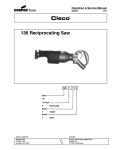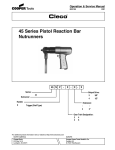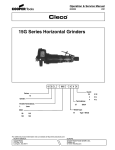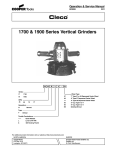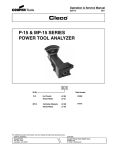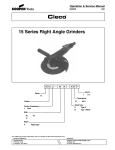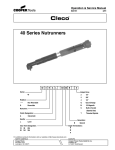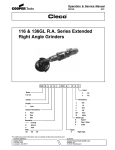Download Cooper Tools Cleco 136 Service manual
Transcript
Operation & Service Manual 823132 2/01 136VGL Series Vertical Grinders 136 V G L - XXX - X X X Guard: Series: 3 4 136 Type: V Vertical 3 In. 4 In. Terminations: Grinder: Throttle Terminations: L Lever RPM: 135 180 For additional product information visit our website at http://www.clecotools.com NORTH AMERICA CooperTools P.O. Box 1410 Lexington, SC 29071 3T 5T 3/8-24 5/8-11 Wheel Type: Sander D Type 27 EUROPE Cooper Power Tools GmbH & Co. Postfach 30 D-73461 Westhausen 1 Safety Recommendations ! WARNING Do not operate without proper wheel guard in place. Impact resistant eye protection must be worn while operating or working near this tool. Wear respirator where necessary. Grinding or other use of this tool may produce hazardous fumes and/ or dust. To avoid adverse health effects utilize adequate ventilation and/or a respirator. Read the material safety data sheet of any materials involved in the grinding process. Cleco grinders are designed to operate on 90 psig (6.2 bar) max. air pressure. If the tool is properly sized and applied, higher air pressure is unnecessary. Excessive air pressure increases the loads and stresses on the tool parts. Installation of a filter-regulator-lubricator in the air supply line is highly recommended. Never use the air hose for supporting, lifting, or lowering the tool. Use a safety line or cable on the tool when working in elevated areas. Before tool is connected to air supply, check throttle for proper operation, i.e., throttle moves freely and returns to closed position. Being careful not to endanger adjacent personnel, clear air hose of accumulated dust and moisture. Use protective barriers where necessary — hot sparks can burn and/or ignite ignite flammable materials. Barriers also help reduce noise levels. Before removing tool from 2 Warning Label WARNING ! OVER Repetitive work motions and/or vibration can cause injury to hands and arms. Use minimum hand grip force consistent with proper control and safe operation. Keep body and hands warm and dry. Avoid anything that inhibits blood circulation. Avoid continuous vibration exposure. Keep wrists straight. Avoid repeated bending of wrists and hands. CAUTION WARNING Hearing protection is recommended in high noise areas (above 85 dBA). Close proximity of other tools, reflective surfaces, process noises, and resonant structures can substantially contribute to the sound level experienced by the user. ! ! Personal hearing protection is recommended when operating or working near this tool. Impact resistant eye protection must be worn while operating or working near this tool. Made in USA WARNING 202409 WARNING LABEL 869491 WARNING LABEL 869974 WARNING TAG CLECO ! 3 • Do not wear clothing that may restrict movement, become entangled or in any way interfere with the safe operation of grinders. 2 • Gloves and other protective clothing should be worn as required. 1 Hearing protection is recommended in high noise areas (above 85 dBA). Close proximity of additional tools, reflective surfaces, process noises, and resonant structures can substantially contribute to the sound level experienced by the operator. For additional information on hearing protection, refer to Federal OSHA Regulations, 29 CFR, Section 1910.95, Occupational Noise Exposure, and American National Standards Institute, ANSI S12.6, Hearing Protectors. 203011 WARNING LABEL 0 Personal hearing protection is recommended when operating or working near this tool. The guard must be securely attached to the grinder with the bolt, nut and lockwasher in place and torqued to 30 - 40 in. lbs. 6 CAUTION NOTE: The grinder must be held so that the opening in the guard is away from the operator. 5 ! The wheel guard is designed to prevent serious injury to the operator in the event of wheel failure and must not be modified in any way. Any wheel guard that is damaged or bent must be replaced. 4 For additional information on eye protection, refer to Federal OSHA Regulations, 29 CFR, Section 1910.133, Eye and Face Protection, and ANSI Z87.1, Occupational and Educational Eye and Face Protection. This standard is available from the American National Standards Institute, Inc., 11 West 42nd Street, New York, NY 10036. WARNING Read Operating Instructions carefully. Follow the Safety Recommendations for your safety and the safety of others. ! Do not remove this tag until the operator of this tool has read these safety precautions. Always wear protective equipment and clothing. service or changing accessories, make sure air line is shut off and drained of air to prevent the tool from operating if the throttle is accidently engaged. The use of a self-relieving valve for this purpose, close to the tool or point of operation, is highly recommended. Warning Label For your safety and the safety of others, read and understand the safety recommendations before operating any grinder. The speed rating, warning tags and warning labels should be maintained or replaced for legibility in the event or damage. Speed rating, warning tags, and warning labels are available from the manufacturer. Before mounting a wheel, after all tool repairs, and whenever a grinder is issued for use, check the free speed of the grinder with a tachometer to make certain that the actual free speed at 90 psig (6.2 bar) does not exceed the rated free speed stamped on the tool. Grinders in use on the job must be similarly checked at least once every twenty hours of operation, or once every week, whichever is more frequent. Checking free speed after the removal of each worn wheel and before mounting a new wheel is highly recommended. ! WARNING Fragments from an abrasive wheel can cause serious injury or death. Do not operate without proper wheel guard in place. INSPECT THE GRINDING WHEEL! Check the maximum safe RPM marked on the wheel. Never use a wheel rated below the actual tool speed. Inspect the wheel for cracks or chips, water stains, or signs of abuse or improper storage. Cracked, chipped or faulty grinding wheels are dangerous. They must be destroyed rather than risk their use by someone who may not notice that they are damaged. Causes of abrasive wheel failures have been traced to such factors as: • Dropping, bumping, or abuse (careless handling of the grinder or wheel) • Improper mounting Safety Recommendations • Imbalance • Improper shipment or storage • Exposure to water, solvents, high humidity, freez ing and extreme temperatures • Mismatched speed ratings • Age Abrasive wheels known to have been subjected to any of the above conditions can burst violently. Never operate a vertical grinder without proper wheel guard in place. CHECK FLANGE Check the grinder spindle and driving flange for signs of damage or abuse. The shape of a Type 27 wheel requires a special flange. The spindle must not be bent and the threads should be free of any damage that might keep an abrasive wheel and its mount from locating centrally or seating properly against the driving flange. ABRASIVE WHEEL MOUNTING & BEGINNING GRINDING OPERATION The adapter nut should be tightened only enough to prevent slippage and satisfactorily transfer the driving torque of the spindle to the wheel through the adapter assembly. Do not over-tighten. Before beginning operations or after mounting a wheel, the tool must be run for one (1) minute in a protected enclosure to check the integrity or the wheel. During this time or any other time, no one should stand in front of or in line of the wheel. When starting work with a cold wheel, apply it gradually to the workpiece until the wheel becomes warm. DO NOT CONTINUE TO USE A GRINDER IF: • It is not equipped with the proper wheel guard • The speed rating of the wheel is less than the speed of the grinder • It starts to vibrate • You sense any changes in tool speed or an unusual increase in noise output that would indicate the tool is running at excessive speed. • You notice excessive end play in the spindle • You hear any unusual sound from the grinder RETURN THE TOOL TO THE TOOL CRIB FOR SERVICE IMMEDIATELY! ! WARNING Repetitive work motions and/or vibration may cause injury to hands and arms. Use minimum hand grip force consistent with proper control and safe operation. Keep body and hands warm and dry. Avoid anything that inhibits blood circulation. Avoid continuous vibration exposure. Keep wrists straight. Avoid repeated bending of wrists and hands. Some individuals may be susceptible to disorders of the hands and arms when performing tasks consisting of highly repetitive motions and/or exposure to extended vibration. Cumulative trauma disorders such as carpal tunnel syndrome and tendonitis may be caused or aggravated by repetitious, forceful exertions of the hands and arms. Vibration may contribute to a condition called Raynaud's Syndrome. These disorders develop gradually over periods of weeks, months, and years. It is presently unknown to what extent exposure to vibrations or repetitive motions may contribute to the disorders. Hereditary factors, vasculatory or circulatory problems, exposure to cold and dampness, diet, smoking and work practices are thought to contribute to the conditions. Any tool operator should be aware of the following warning signs and symptoms so that a problem can be addressed before it becomes a debilitating injury.Any user suffering prolonged symptoms of tingling, numbness, blanching of fingers, clumsiness or weakened grip, nocturnal pain in the hand, or any other disorder of the shoulders, arms, wrists, or fingers is advised to consult a physician. If it is determined that the symptoms are job related or aggravated by movements and postures dictated by the job design, it may be necessary for the employer to take steps to prevent further occurrences. These steps might include, but are not limited to, repositioning the workpiece or redesigning the workstation, reassigning workers to other jobs, rotating jobs, changing work pace, and/or changing the type of tool used so as to minimize stress on the operator. Some tasks may require more than one type of tool to obtain the optimum operator/tool/ task relationship. The following suggestions will help reduce or moderate the effects of repetitive work motions and/or extended vibration exposure: • Use a minimum hand grip force consistent with proper control and safe operation • Keep body and hands warm and dry (cold weather is reported to be a major factor contributing to Raynaud's Syndrome) • Avoid anything that inhibits blood circulation —Smoking Tobacco (another contributing factor) —Cold Temperatures —Certain Drugs Avoid Extension OK Neutral Avoid Flexion Avoid Radial Deviation OK Avoid Neutral Ulnar Deviation • Tasks should be performed in such a manner that the wrists are maintained in a neutral position, which is not flexed, hyperextended, or turned side to side • Stressful postures should be avoided — select a tool appropriate for the job and work location • Avoid highly repetitive movements of hands and wrists, and continuous vibration exposure (after each period of operation, exercise to increase blood circulation) • Use quality abrasive wheels • Keep tool well maintained and replace worn parts Work gloves with vibration reducing liners and wrist supports are available from some manufacturers of industrial work gloves. Tool wraps and grips are also available from a number of different manufacturers. These gloves, wraps, and wrist supports are designed to reduce and moderate the effects of extended vibration exposure and repetitive wrist trauma. Since they vary widely in design, material, thickness, vibration reduction, and wrist support qualities, it is recommended that the glove, tool wrap, or wrist support manufacturer be consulted for items designed for your specific application. WARNING! Proper fit of gloves is important. Improperly fitted gloves may restrict blood flow to the fingers and can substantially reduce grip strength. 3 Safety Recommendations USE QUALITY ABRASIVE WHEELS PROPER LUBRICATION The primary source of vibration when using a portable grinder is an abrasive wheel that is out of balance, out of round, untrue, or possibly any combination of all three. An automatic in-line filter-regulator-lubricator is recommended as it increases tool life and keeps the tool in sustained operation. The inline lubricator should be regularly checked and filled with a good grade of 10W machine oil. Proper adjustment of the in-line lubricator is performed by placing a sheet of paper next to the exhaust ports and holding the throttle open approximately 30 seconds. The lubricator is properly set when a light stain of oil collects on the paper. Excessive amounts of oil should be avoided. The use of quality abrasive wheels which are well balanced, round, and true is highly recommended as they have been found to significantly reduce vibration. Some abrasive wheels lose their balance, roundness, and trueness as they wear from use. Because of the abusive nature of the vibration caused by out of balance, out of round, and untrue condition of some abrasive wheels, it is felt that these wheels are more susceptible to failure. Excessive vibration may signal eminent wheel failure. (Out of balance abrasive wheel, caused by grinding the wheel to a stop after the power has been shut off can result in changes to the balance and shape of the wheel.) Be sure the grinding wheel has stopped before setting the tool down. Set the tool in a tool rest or tool holder when not in use. STORAGE In the event that it becomes necessary to store the tool for an extended period of time (overnight, weekend, etc.), it should receive a generous amount of lubrication at that time and run for several seconds to distribute the oil before disconnecting from the air supply. This will reduce the possibility of corrosion and displace any water that may be trapped in the tool. WIRE BRUSHES Note: Water in the air system increases tool maintenance costs. If a grinder is used for wire brushing applications the same problems of balance, roundness, and trueness as experienced with abrasive wheels prevail. Use quality wire brushes. Proper repair procedures and the use of original Cleco service parts and bearings rather than substitutes will return the tool to factory specifications of precision and balance, and minimize vibration. USE A PREVENTIVE MAINTENANCE PROGRAM Tool abuse or poor maintenance procedures can amplify and contribute to the vibration produced by the abrasive wheel. A preventive maintenance program featuring scheduled periodic inspections and proper maintenance is the best way to assure safety in your portable grinding operations. A well managed program can, for example, detect such things as speed variations due to wear, flanges or spindles that have been damaged from abuse, or bad bearings damaged by foreign matter or lack of lubrication. Problems such as these can affect the wheel trueness when the grinder is running and contribute to the vibration. Rotor blades that are worn or chipped can lock up motor and result in grinding wheel spinoff and should be replaced. Rotor blades should be checked periodically and replaced if they measure less than 7/32" (5.5mm) at either end. Replace if 3/16" (4.7mm) or less at either end. 4 For more information, see the latest edition of ANSI B186.1, Safety Code for Portable Air Tools, and ANSI B7.1 Safety Requirements for the Use, Care, and Protection of Abrasive Wheels available from the American National Standards Institute, Inc., 11 West 42nd Street, New York, NY 10036. OPERATING INSTRUCTIONS READ SAFETY RECOMMENDATIONS BEFORE OPERATING TOOL. SELECT OR SAND ROTOR COLLAR TO THIS MEASUREMENT PLUS .0015" (.038mm) The136 Series Vertical Grinders are designed to operate on 90psig (6.2 bar) maximum air pressure, using a 5/16" hose up to 8' in length. If additional length is required, the next larger hose size may be connected to the 8' whip hose. LUBRICATION An automatic in-line filter-lubricator is recommended as it increases tool life and keeps the tool in sustained operation. The in-line lubricator should be regularly checked and filled with a good grade of 10W machine oil. Proper adjustment of the in-line lubricator is performed by placing a sheet of paper next to the exhaust ports and holding the throttle open approximately 30 seconds. The lubricator is properly set when a light stain of oil collects on the paper. Excessive amounts of oil should be avoided. STORAGE In the event that it becomes necessary to store the tool for an extended period of time (overnight, weekend, etc.), it should receive a generous amount of lubrication at that time and run for several seconds to distribute the oil before disconnecting from the air supply. SERVICE INSTRUCTIONS DISASSEMBLY Unscrew the bearing retainer (left hand threads) from the housing. This will allow the motor unit to be removed from the front of the motor housing. Use a suitable driver to drive the front rotor shaft out of the front rotor bearing. After removing the rotor collar, cylinder and rotor blades, drive the rear rotor shaft out of the rear rotor bearing. FRONT BEARING PLATE INNER RACE OF BEARING ROTOR COLLAR .OO15" (.038mm) Clearance FRONT BEARING PLATE INNER RACE OF BEARING Next, slip on the front bearing plate and the front rotor bearing. It is recommended that new rotor blades be installed at each repair cycle. If not replaced, the used ones must measure a minimum of 7/32" (5.5mm) at both ends.Failure of these parts could cause damage to more expensive components. Replace if 3/16" (4.7mm) or less at either end. Insert the rotor blades in the rotor and slip the cylinder over the rotor. Assemble the rear rotor bearing into the rear rotor shaft by lightly tapping on the inner race of the rear rotor bearing until the rear bearing clamps against the rotor preventing rotation. Tap the rear rotor shaft until the rotor turns freely and will not touch either bearing plate under axial load. REASSEMBLY The tool is reassembled in reverse order of disassembly with special care being exercised when assembling the motor unit. To reassemble the motor unit, assemble the front rotor bearing into the front bearing plate. Fit the rotor collar by sanding on a flat sheet of sandpaper so it stands out .0015" (.038mm) from the face of the front bearing plate when the front rotor bearing is held toward the rear. Slip the rotor collar (chamfered face first) over the front shaft of the rotor. Slip the motor unit into the motor housing and tighten the bearing retainer (left hand threads) securely. After reassembly, place a few drops of 10W machine oil in the air inlet before installing the hose. This will ensure positive lubrication of all motor parts as soon as the air is applied. CAUTION: After the tool is reassembled, be sure to check it for proper speed with a dependable tachometer before returning it to service. 5 6 PARTS LIST — 136 SERIES VERTICAL GRINDER Part No. 202105 202341 203011 203382 203384 412775 812165 834228 843422 843586 843587 847272 847411 847525 847528 847767 849905 867929 869445 869448 869449 869451 869457 869487 869488 869489 869491 869492 869495 869496 869499 869638 869664 869782 869855 869856 Name of Part Toggle Throttle Lever Caution Tag (included in 203384, 869487) 4" Type 27 Wheel Guard 13,500 RPM Motor Housing (includes 869491, 203011, 834228) Air Inlet Screen Cylinder Pin (included in 869451) Drive Screw (incluced in 203384, 869487) Spindle End Nut Back Up Pad Back Up Pad Nut "O"-Ring 5/8" X 3/4" "O" -Ring 11/16 x 3/16" Rotor Collar Rotor Front Bearing Throttle Valve Spring 3" Type 27 Wheel Guard Air Inlet Bushing Rotor Rear Bearing Front Bearing Plate Rotor Blade Cylinder (includes 812165) Throttle Lever Pin 18,000 RPM Motor Housing (includes 869491, 203011, 834228) Throttle Pin Bushing Throttle Valve Instruction Tag (Included in 203384, 869487) Muffler Spindle Adaptor Type 27 Wheel Driving Flange Front Bearing Retainer Rear Bearing Plate Throttle Pin Rotor Spring Pawl Pin Qty. 1 1 1 1 1 1 1 2 1 1 1 1 1 1 1 1 1 1 1 1 4 1 1 1 1 1 1 1 1 1 1 1 1 1 1 1 The complete motor housing may be purchased as a subassembly using the Part No. listed below: 136VGL-135 — Part No. 201406 136VGL-180 — Part No. 861829 The Lock -Off Lever may be purchased as a subassembly using Part No. 201411. 7 8 CooperTools 670 Industrial Drive Lexington, SC 29072 Phone: (803) 359-1200 Fax: (803) 359-2013 www.clecotools.com








